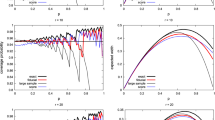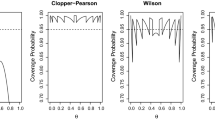Abstract
The problems of constructing prediction intervals (PIs) for the binomial and Poisson distributions are considered. New highest posterior mass (HPM) PIs based on fiducial approach are proposed. Other fiducial PIs, an exact PI and approximate PIs are reviewed and compared with the HPM-PIs. Exact coverage studies and expected widths of prediction intervals show that the new prediction intervals are less conservative than other fiducial PIs and comparable with the approximate one based on the joint sampling approach for the binomial case. For the Poisson case, the HPM-PIs are better than the other PIs in terms of coverage probabilities and precision. The methods are illustrated using some practical examples.





Similar content being viewed by others
References
Agresti A, Coull BA (1988) Approximate is better than “exact” for interval estimation of binomial proportion. Am Stat 52:119–125
Bain LJ, Patel JK (1993) Prediction intervals based on partial observations for some discrete distributions. IEEE Trans Reliab 42:459–463
Brown LD, Cai T, Das Gupta A (2001) Interval estimation for a binomial proportion (with discussion). Stat Sci 16:101–133
Cai T (2005) One-sided confidence intervals in discrete distributions. J Stat Plan Inference 131:63–88
Clopper CJ, Pearson ES (1934) The use of confidence or fiducial limits illustrated in the case of the binomial. Biometrika 26:404–413
Cox DR (1953) Some simple approximate tests for Poisson variates. Biometrika 40:354–360
Dawid AP, Stone M (1982) The functional-model basis of fiducial inference. Ann Stat 10:1054–1074
Efron B (1998) R. A. Fisher in the 21st century. Stat Sci 13:95–114
Faulkenberry GD (1973) A method of obtaining prediction intervals. J Am Stat Assoc 68:433–435
Fisher RA (1930) Inverse probability. In: Proceedings of the Cambridge philosophical society, London, vol xxvi, pp 528–535
Fisher RA (1935) The fiducial argument in statistical inference. Ann Eugen VI:91–98
Hahn GJ, Meeker WQ (1991) Statistical intervals: a guide to practitioners. Wiley, New York
Hannig J (2009) On generalized fiducial inference. Stat Sin 19:491–544
Hannig J, Iyer H, Lai RCS, Lee T (2016) Generalized fiducial inference: a review and new results. J Am Stat Assoc 111:1346–1361
Krishnamoorthy K, Lee M (2010) Inference for functions of parameters in discrete distributions based on fiducial approach: binomial and Poisson cases. J Stat Plan Inference 140:1182–1192
Krishnamoorthy K, Peng J (2011) Improved closed-form prediction intervals for binomial and Poisson distributions. J Stat Plan Inference 141:1709–1718
Krishnamoorthy K (2015) Handbook of statistical distributions with applications. Chapman & Hall/CRC, Boca Raton, FL
Krishnamoorthy K, Lee M, Zhang D (2017) Closed-form fiducial confidence intervals for some functions of independent binomial parameters with comparisons. Stat Methods Med Res 26:43–63
Montgomery DC (1996) Introduction to statistical quality control Hoboken. Wiley, New York
Nelson W (1982) Applied life data analysis. Wiley, Hoboken, NJ
Stevens WL (1950) Fiducial limits of the parameter of a discontinuous distribution. Biometrika 37:117–129
Thatcher AR (1964) Relationships between Bayesian and confidence limits for prediction. J R Stat Soc Ser. B 26:176–192
Thulin M (2014) The cost of using exact confidence intervals for a binomial proportion. Electron J Stat 8:817–840
Thulin M, Zwanzig S (2017) Exact confidence intervals and hypothesis tests for parameters of discrete distributions. Bernoulli 23:479–502
Tsui KW, Weerahandi S (1989) Generalized p-values in significance testing of hypotheses in the presence of nuisance parameters. J Am Stat Assoc 84:602–607
Vohr BR, Carty LM, Moore PE, Letourneau K (1998) The Rhode island hearing assessment program: experience with statewide hearing screening (1993–1996). J Pediatr 133:353–357
Wang H (2008) Coverage probability of Prediction intervals for discrete random variables. Comput Stat Data Anal 53:17–26
Wang H (2010) Closed form prediction intervals applied for disease counts. Am Stat 64:250–256
Wang H, Tsung F (2009) Tolerance intervals with improved coverage probabilities for binomial and Poisson variables. Technometrics 51:25–33
Wang CM, Hannig J, Iyer HK (2012) Fiducial prediction intervals. J Stat Plan Inference 142:1980–1990
Weerahandi S (1993) Generalized confidence intervals. J Am Stat Assoc 88:899–905
Acknowledgements
The authors are grateful to two reviewers and the editor for providing valuable comments and suggestions.
Author information
Authors and Affiliations
Corresponding author
Electronic supplementary material
Below is the link to the electronic supplementary material.
Appendices
Appendix A
We shall now provide an exact expression for the probability mass function of \(Y^*\) defined in (8). Note that
Appendix B
We shall now provide an exact expression for the probability mass function of \(Y^*\) defined in (14) for predicting a future observation from a Poisson distribution. We first note that \(\chi ^2_a/b\) is distributed as a gamma random variable with shape parameter a / 2 and the scale parameter 2 / b. Letting \(a=2x+1\) and \(b=2n\), we see that
Rights and permissions
About this article
Cite this article
Krishnamoorthy, K., Lv, S. Highest posterior mass prediction intervals for binomial and poisson distributions. Metrika 81, 775–796 (2018). https://doi.org/10.1007/s00184-018-0658-z
Received:
Published:
Issue Date:
DOI: https://doi.org/10.1007/s00184-018-0658-z




